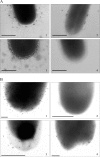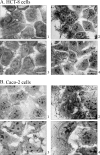Anaerobic conditions promote expression of Sfp fimbriae and adherence of sorbitol-fermenting enterohemorrhagic Escherichia coli O157:NM to human intestinal epithelial cells
- PMID: 18083855
- PMCID: PMC2258567
- DOI: 10.1128/AEM.02496-07
Anaerobic conditions promote expression of Sfp fimbriae and adherence of sorbitol-fermenting enterohemorrhagic Escherichia coli O157:NM to human intestinal epithelial cells
Abstract
The sfp gene cluster, unique to sorbitol-fermenting (SF) enterohemorrhagic Escherichia coli (EHEC) O157:NM strains, encodes fimbriae that mediate mannose-resistant hemagglutination in laboratory E. coli strains but are not expressed in wild-type SF EHEC O157:NM strains under standard laboratory conditions. We investigated whether Sfp fimbriae are expressed under conditions that mimic the intestinal environment and whether they contribute to the adherence of SF EHEC O157:NM strains to human intestinal epithelial cells. The transcription of sfpA (encoding the major fimbrial subunit) was upregulated in all strains investigated, and all expressed SfpA and possessed fimbriae that reacted with an anti-SfpA antibody when the strains were grown on solid media under anaerobic conditions. Sfp expression was absent under aerobic conditions and in liquid media. Sfp upregulation under anaerobic conditions was significantly higher on blood agar and a medium simulating the colonic environment than on a medium simulating the ileal environment (P < 0.05). The induction of Sfp fimbriae in SF E. coli O157:NM strains correlates with increased adherence to Caco-2 and HCT-8 cells. Our data indicate that the expression of Sfp fimbriae in SF E. coli O157:NM strains is induced under conditions resembling those of the natural site of infection and that Sfp fimbriae may contribute to the adherence of the organisms to human intestinal epithelium.
Figures



Similar articles
-
Pathogenic potential of emergent sorbitol-fermenting Escherichia coli O157:NM.Infect Immun. 2008 Dec;76(12):5598-607. doi: 10.1128/IAI.01180-08. Epub 2008 Oct 13. Infect Immun. 2008. PMID: 18852247 Free PMC article.
-
Novel type of fimbriae encoded by the large plasmid of sorbitol-fermenting enterohemorrhagic Escherichia coli O157:H(-).Infect Immun. 2001 Jul;69(7):4447-57. doi: 10.1128/IAI.69.7.4447-4457.2001. Infect Immun. 2001. PMID: 11401985 Free PMC article.
-
Phylogeny, clinical associations, and diagnostic utility of the pilin subunit gene (sfpA) of sorbitol-fermenting, enterohemorrhagic Escherichia coli O157:H-.J Clin Microbiol. 2004 Oct;42(10):4697-701. doi: 10.1128/JCM.42.10.4697-4701.2004. J Clin Microbiol. 2004. PMID: 15472329 Free PMC article.
-
Long polar fimbriae contribute to pathogenic Escherichia coli infection to host cells.Appl Microbiol Biotechnol. 2019 Sep;103(18):7317-7324. doi: 10.1007/s00253-019-10014-x. Epub 2019 Jul 29. Appl Microbiol Biotechnol. 2019. PMID: 31359104 Review.
-
F4 fimbriae expressed by porcine enterotoxigenic Escherichia coli, an example of an eccentric fimbrial system?J Mol Microbiol Biotechnol. 2004;7(4):155-69. doi: 10.1159/000079825. J Mol Microbiol Biotechnol. 2004. PMID: 15383714 Review.
Cited by
-
Pathogenic potential of emergent sorbitol-fermenting Escherichia coli O157:NM.Infect Immun. 2008 Dec;76(12):5598-607. doi: 10.1128/IAI.01180-08. Epub 2008 Oct 13. Infect Immun. 2008. PMID: 18852247 Free PMC article.
-
Sorbitol-Fermenting Enterohemorrhagic Escherichia coli O157:H- Isolates from Czech Patients with Novel Plasmid Composition Not Previously Seen in German Isolates.Appl Environ Microbiol. 2017 Nov 16;83(23):e01454-17. doi: 10.1128/AEM.01454-17. Print 2017 Dec 1. Appl Environ Microbiol. 2017. PMID: 28970221 Free PMC article.
-
Plasmids from Shiga Toxin-Producing Escherichia coli Strains with Rare Enterohemolysin Gene (ehxA) Subtypes Reveal Pathogenicity Potential and Display a Novel Evolutionary Path.Appl Environ Microbiol. 2016 Oct 14;82(21):6367-6377. doi: 10.1128/AEM.01839-16. Print 2016 Nov 1. Appl Environ Microbiol. 2016. PMID: 27542930 Free PMC article.
-
Microaerobic conditions enhance type III secretion and adherence of enterohaemorrhagic Escherichia coli to polarized human intestinal epithelial cells.Environ Microbiol. 2010 Sep;12(9):2426-35. doi: 10.1111/j.1462-2920.2010.02216.x. Epub 2010 Apr 7. Environ Microbiol. 2010. PMID: 20406285 Free PMC article.
-
Shiga toxin production and translocation during microaerobic human colonic infection with Shiga toxin-producing E. coli O157:H7 and O104:H4.Cell Microbiol. 2014 Aug;16(8):1255-66. doi: 10.1111/cmi.12281. Epub 2014 Mar 21. Cell Microbiol. 2014. PMID: 24612002 Free PMC article.
References
-
- Aldick, T., M. Bielaszewska, W. Zhang, J. Brockmeyer, H. Schmidt, A. W. Friedrich, K. S. Kim, M. A. Schmidt, and H. Karch. 2007. Hemolysin from Shiga toxin-negative Escherichia coli O26 strains injures microvascular endothelium. Microbes Infect. 9:282-290. - PubMed
-
- Allison, L., S. Harding, M. Locking, K. Pollock, J. Evans, H. Knight, G. Foster, J. Cowden, and M. Hanson. 2006. Sorbitol-fermenting E. coli O157 in Scotland—laboratory investigation of an outbreak of haemolytic uraemic syndrome, abstr. P01.1.01, p. 4. In Abstracts of the 6th International Symposium on Shiga Toxin (Verocytotoxin)-Producing Escherichia coli Infections (VTEC 2006). Cambridge Publishing, West Leederville, Australia.
-
- Ammon, A., L. R. Peterson, and H. Karch. 1999. A large outbreak of hemolytic uremic syndrome caused by an unusual sorbitol-fermenting strain of E. coli O157:H−. J. Infect. Dis. 179:1274-1277. - PubMed
-
- Ando, H., H. Abe, N. Sugimoto, and T. Tobe. 2007. Maturation of functional type III secretion machinery by activation of anaerobic respiration in enterohaemorrhagic Escherichia coli. Microbiology 153:464-473. - PubMed
-
- Bettelheim, K. A., M. Whipp, S. P. Djordjevic, and V. Ramachandran. 2002. First isolation outside Europe of sorbitol-fermenting verocytotoxigenic Escherichia coli (VTEC) belonging to O group O157. J. Med. Microbiol. 51:713-714. - PubMed
Publication types
MeSH terms
Substances
LinkOut - more resources
Full Text Sources

